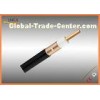Low Frequency Radiating Mode Leaky Coax Cable 50 Ohm For Telecommunication
Product Description
A leaky coax cable is very similar to normal coaxial cable in its construction. The major difference is in the cable's outer conductor. Normal coaxial cables use outer conductor shields that are designed to minimize RF leakage. However, the outer conductor of a typical leaky coax cable has holes or openings in the outer conductor to allow a controlled amount of RF signal to leak out into the surrounding environment. Although most of the signal still travels through the cable, these openings allow the signal to radiate out from the cable creating an RF field around the cable.
Leaky coaxial cables have been used for many years as wireless feeders in coal mines and vehicular tunnels. More recently, leaky coax has started to be used as an antenna for in-building wireless systems for hard-to-cover areas such as lift shafts, office block or hotel corridors, warehouses, and building-to-building tunnels.
Features
Dielectric: Foamed polyethylene (Φ 22.50±0.20)
Jacket: PE/LSOH flame-retardant polyolefin (Φ 27.20±0.20)
Installation temperature range: -40 ~ +80
Operating frequency: 75 to 1000 MHz
Mechanical Characteristics
| Weight | 0.450kg/m | ||
| Maximum pulling force | 1350 N | ||
| Minmum bending radius - Single | 250 mm | ||
| Operating temperature range | -55 ~ +85 | ||
| Storage temperature range | -55 ~ +85 |
Electrical Characteristics
| Characteristics impedance | 50 ± 2Ω | ||||
| Velocity | 89% | ||||
| Capacitance | 75 pF/m | ||||
| Stop bands | 180 to 280 MHZ, 500 to 580 MHz | ||||
| Return Loss (VSWR) (±3%) | 1.30 @ 75 ~ 150 MHz 1.30 @ 300 ~ 500 MHz 1.30 @ 650 ~ 800 MHz 1.30 @ 800 ~ 1000 MHz | ||||
| Peak power rating | 91kW | ||||
| DC test voltage | 6000V | ||||
| Jacket spark test voltage | 8000V | ||||
| Insulation resistance |
Company QR code Anytime Anywhere Mobile |








